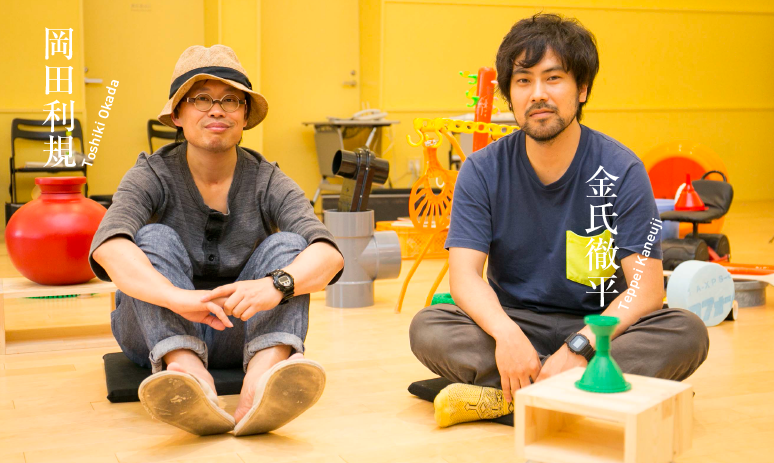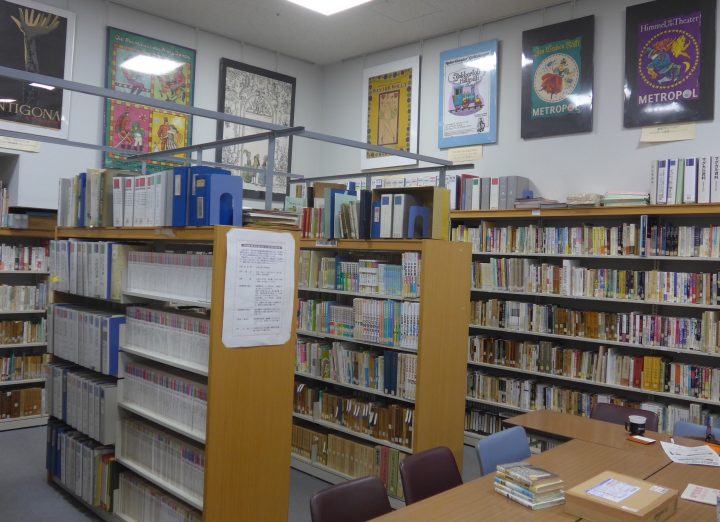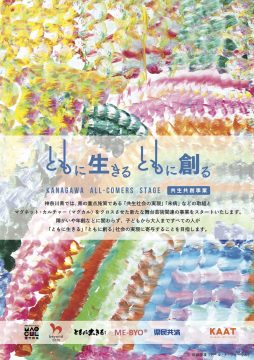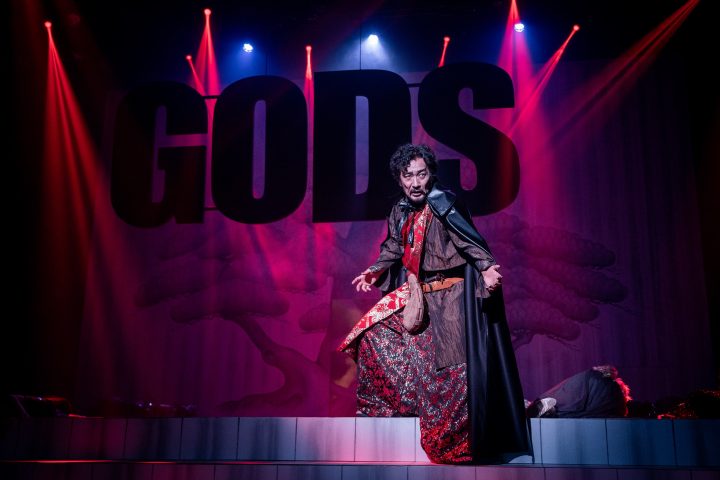Interview with Toshiki Okada and Teppei Kaneuji | There are sensitivities that can only be conveyed by children

Text: Taisuke Shimanuki Photo: Masamasa Nishino 2015.7.17
This summer, KAAT Kanagawa Arts Theatre will be presenting the "KAAT Kids Program." Among the programs, there is one title that will make you feel a little nostalgic: "Ms. Wakatta's Cookies." This is a theatrical adaptation of a popular picture book about a carefree girl who works at a dry cleaning shop and who always says "I know, I know," and who has a variety of strange experiences. The production will be directed by Toshiki Okada of the comedy duo Chelfitsch, with contemporary artist Teppei Kaneuji for stage design and singer-songwriter Kenta Maeno for music, and will bring to life the fantastical world of "Ms. Wakatta" on stage. We had the opportunity to interview Okada and Kaneuji during rehearsals. How will they shape this work, in which strange characters appear one after another and the room keys speak and sing in human language?
▶ KAAT Kids Program 2015 Delicious and Funny Play "Wakatta-san's Cookies"
Toshiki Okada
Playwright, novelist, and founder of the theatre company Chelfitsch. Born in Yokohama in 1973.
He lives in Kumamoto City. His unique physicality and linguistic expression have earned him such acclaim that he is spoken of before or since Okada. In 1997, he founded the theatre company Chelfitsch. In 2005, he won the 49th Kishida Kunio Drama Award for Five Days in March. In 2007, he made his overseas debut at the Kunsten Festival des Arts, and his works have been performed in 70 cities around the world. In 2008, he won the 2nd Oe Kenzaburo Prize for The End of the Special Time Allowed to Us. He is also attracting attention as a novelist. About KAAT As Chelfitsch, he released The Sonic Life of a Giant Tortoise in 2011, Current Location in 2012, Ground and Floor in 2013, and Super Premium Soft W Vanilla Rich in 2014. http://chelfitsch.net/
Teppei Kaneuji
Contemporary artist, born in Kyoto in 1978 and currently living in Kyoto.
In 2001, she studied abroad at the Royal College of Art (London). In 2003, she completed her graduate studies in sculpture at Kyoto City University of Arts. She creates works using collage-like techniques using everyday objects such as plastic products, toys such as character figures, magazine clippings, and stickers. In 2009, she held "Melting City, Blank Forest" at the Yokohama Museum of Art, making her the youngest artist to ever hold a solo exhibition at the museum, and has also held numerous solo and special exhibitions overseas. In recent years, she has participated in the Singapore Biennale 2011, the special exhibition "Mono No Aware. Beauty of Things. Japanese Contemporary Art" (2013-14) at the Hermitage Museum, and the solo exhibition "Towering Something" (2013, Ullens Center for Contemporary Art) in Beijing. He also worked on the stage art for "We Can't Understand Like Appliances" (written and directed by Okada Toshiki, starring Moriyama Kaiji) in 2011 and "Happy Days" by ARICA+ Kaneuji Teppei (premiered at the Aichi Triennale 2013) in 2013. http://www.teppeikaneuji.com/
Okada's first challenge
This is your first attempt at a theatrical production for children. Why did you choose the picture book "Wakatta-san no Cookies" as the subject?
Okada : My child had borrowed it from the library and we were reading it together, and it just clicked with me.
── Why is that? The "Wakatta-san" series is a very mysterious story. It's set in another world, with a key suddenly starting to talk to you, but in the second half it turns into a guidebook for baking cookies.
Okada : When I was making a work for children, I didn't want to do something with a Western design like an Andersen fairy tale. I also didn't want to do something moralistic. The story of "Wakatta-san" is crazy and interesting, and it meets these two conditions. Also, I couldn't imagine how to turn this original work into a play, so I thought I'd give it a try. I wanted to take on the challenge.
── Why did you ask Mr. Kane to design the stage design?
Okada : I was confident that with Mr. Kaneji in the team, this story could be adapted into a play.
Kim : I had never read "Wakatta-san". So I read it, and at first it seemed like a moral story, but it was a strange story that gradually slipped away. I thought it was really interesting how the format of the picture book itself changed.

Once rehearsals began, I heard that Mr. Kaneji had sent over a large number of items. In the rehearsal that we were shown earlier, there were toys, metal cylinders, hoses and so on lying around everywhere, and the story progressed as the actors moved them.
Okada : First, I made a few requests to Mr. Kaneuji, saying, "I want something that looks like ___." I think there were three: a car, laundry, and keys.
Kaneji : I participated in several workshops before the art plan was decided, where Okada and his team were experimenting with changing the meaning of space and movement, and I interpreted it in my own way: "Is what they want from me something that looks different or can look like anything?" So I sent them some things that looked like cars or laundry. On the other hand, I sent them additional things that looked interesting but I didn't know what they would be used for. When I actually went to rehearsals, it was fun to see how they were used and combined in ways I never expected.
--Today you brought along a flat cricket bat (a baseball-like sport that originated in England).
Kaneuji : I saw this in the last rehearsal and thought it might be useful.
Okada : But I already have enough, so I wonder what to do (laughs).
Theatre and sculpture are closely related
--You two also collaborated on the 2011 film Kaden no you ni wa kariaenai. Did that experience have a big impact on you?
Okada : Of course it is a big factor. But I think what's even bigger than that is that Mr. Kaneji became interested in theater after seeing "Like a Home Appliance." And I think that the way he has that interest really captures the essence of theater. I don't think that's something you can easily grasp just by being involved in theater for a long time.
── What did you gain from theater?
Kaneuji : The big point for me was that I realized that things like the meaning of things changing, the way they look, and so on, happen naturally on stage. This is close to what I'm trying to do in contemporary art, but it's been difficult to realize in museums and galleries.
Okada : I once heard a sculptor say that sculpting in modern times is not just about carving, but about using sculptural thinking. That makes sense. So if someone who has studied sculpture has a taste for theater, they can also use theatrical thinking.

Photo on the left: "We can't understand each other like home appliances" 2011
──Today's rehearsal was certainly very sculptural. You combine the space with the actors' bodies, adding something or taking something away. Or you try to divide one event into multiple parts. For example, in the scene where cookies are baked in an oven, the box with wheels like a minecart represents the outside of the oven, and the circular cylinder a little distance away seems to represent the inside of the oven. Things that are essentially the same are placed on stage divided by function or role. There are also sculptures that look like people from one direction, but look like ships from another.
Kaneuji : That's exactly right. On stage, things are constantly being added and subtracted, and things are constantly changing. I think it can be seen as a sculpture that is constantly moving.
Okada : Although it's aimed at children, "Wakatta-san" makes use of a variety of techniques, such as overlapping representations.
Kim : It's quite complicated.
Okada : Adults know a lot of difficult words, so when they see something, they tend to classify it as "concrete" or "abstract," right? In that sense, I think "Wakatta-san" can be said to be abstract. But that's not important. What's important is whether it's an expression that comes as an experience. We've done a few rehearsals so far, and we've had children watch, and what I really thought was that children are such good audiences. They don't need to know difficult words to directly absorb the experience.
Kimuji : I attended a preview once, and they were able to accurately see what we value.
Okada : (suddenly taking out something that looks like a plastic spatula) By the way, do you know what this is?
-- Hmm, is it a washing machine part?
Okada : This is an attachment that adjusts the cutting length of a lawnmower. At a glance, you wouldn't know it.
Kaneuji : There are things whose uses are hard to imagine because of their unfamiliar shapes, and things that are commonly used in one country can become abstract in another cultural sphere. I aim to mix various rules like that in the same space, and yet still coexist.
──Adults tend to find something that is close to their knowledge even when they are unfamiliar, and understand it as "this must be ___", or they tend to be convinced by words. However, children generally do not recognize objects based on the presence or absence of knowledge, so they may be able to accept a space where such different rules coexist without question.
Who will be affected by the "magic"?
-- In the flyer for "Wakatta-san," Okada uses the word "mahou" (magic).
Okada : "Magic" is a word that even children can understand, but it is also a word that accurately describes what we do. In Chelfitsch's previous work (We Are Intact Others), we considered the concept of "conception," and "magic" could be said to be another way of saying that.
── In your book "Retrogression: A Dramatic Theory for Transformation," you also use the word "fertilization."
Okada : On a stage, there are actors and a set. However, no matter how concretely those people and objects look, they cannot be realized as they are. In order for them to become what they are, "magic" is absolutely necessary. That is something that is essential to theater.
In "Sokukou" you write: "In my view of what theater is, the audience plays an increasingly important role," "I have come to judge the quality of a performance on stage... by the impact it has on the audience," and "Actors are not responsible for the representation, but simply help the representation to form within the audience." In other words, "conception" is about awakening some kind of image in the mind of the audience.
Okada : That's why I think "Wakatta-san" is a very aesthetic piece. Because the piece isn't bound by a theme or moral, it may be the most aesthetic piece I've ever made.
Kaneuji : Unlike the stage, in art where the work is presented alone, it is rare to feel anything from the audience's reaction, and it is almost impossible for me to always be in the same place as the audience. That was something that had always been bothering me, but Okada's words, "The magic is not in the work, but in the audience. Create magic in the audience," made it clear to me. To repeat, I think that's what I was trying to do with art.
Okada : That said, there are many types of magic/conception, and I think that requiring long periods of time and contemplation is difficult for children. Something that comes after boredom, like a Robert Wilson play or a Michelangelo Antonioni film, is different.
These artists have created works that, through meditative experiences, evoke a different sense of time and images that are different from what we have actually experienced or seen.
Okada : That's true. I'm not planning on doing that this time. My motto this time is to cast a clear, immediate magic spell.
You will also be presenting a performance piece during the exhibition period. It will be titled " Ghost Sculpture Lecture " and will be held on July 26th for free.
Kaneuji : It's based on the piece "Ghost of the Lecture" that I presented at the Kyoto Art Center in 2014, and extracts sculptural elements from it.

Left: "Ghost in the Lecture" 2014
── What kind of work was "Ghost of the Lecture"?
Kaneuji : In Kyoto, I started with the theme of "Rinpa," and then I extracted things that I associated with it, such as tracing illustrations and the fictional nature of history. I also asked a critic to give a lecture on the relationship between Rinpa and my work, and had the actor memorize all of the content and speak it. At the same time, I taught him all the steps of how I usually make my works, and had him make a sculpture on the spot.
So you are installing all of the content of the lectures and the gestures you use in creating the work into the actors' choreography. That sounds very complicated and difficult.
Kaneuji : But actors have such amazing performance abilities that they can create the exact same thing on stage. In other words, it's a performance as a sculpture that is automatically replicated. This time, it's just a sculpture, and I, Okada, and Kenta Maeno, who is in charge of the music for "Wakatta-san~" will create it. I'm very interested in people with different roles playing different roles.
Theater helps us regain the "power to experience"
Kaneuji uses the word "ghost" in his performances, but images of the dead and ghosts also appear frequently in Okada's recent works.
Okada : I think the ghostly is the gap between representation and matter that seems to overlap but never does. For example, something that occurs between an actor and a character. In that sense, theater is very ghostly.
In Wakatta-san, not only the actors but also the stage design contain a ghostly sense of misalignment. The roles of objects change and their shapes change depending on the scene.
Okada : That being said, in the end, everything I've said can be dismissed as "playing house" (laughs). Even though people say they're doing something technically advanced, it's no different from what kids do normally. I want to be happy that there's no difference.
Kaneuji : It was like, when we got as far as we could pursue it, we were actually doing the same thing as kids.

--Compared to the fact that it's "unintelligible like an appliance," does that mean that you can "understand" children?
Okada : That may be true. While creating "Wakatta-san", I sometimes think about the difference between children and adults. When we hold a rehearsal, children easily experience what we want them to experience. On the other hand, adults can't always do that. If you live in a society like this, the process of becoming an adult is also a process of losing the ability to grasp experience as experience. So I've been thinking recently that in order for adults to grasp things like children, they need to regain that ability.
--In other words, "playing house" is the process of regaining the ability to experience, and perhaps it is possible to regain this ability through the works of Okada and Kaneuji?
Kim : You might be able to experience the state of mind when you acquire something. It's like the experience itself is pinpointed and enters the audience.
Okada : I think that sharing the space with children and watching the play together with them will probably be a great help in regaining that interest. They will guide you. If you are dealing with a social theme or something like that, it is more cost-effective to present aesthetic ideas to children, and it is really fun to create a play for children.



